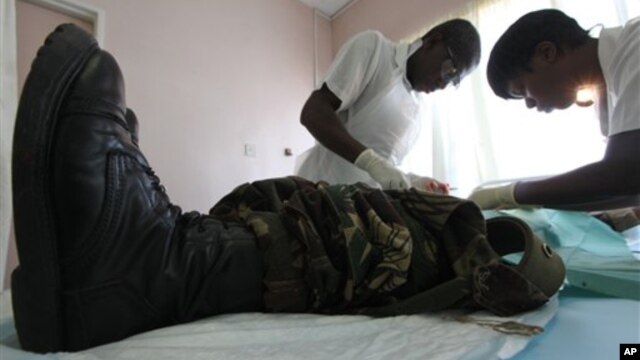
Male Circumcision has been proven to slow the spread of HIV/AIDS in Africa. But a new study shows that in the short-term the surgical technique could actually increase the risk of infection for female partners unless precautions are taken.
The World Health Organization says male circumcision can greatly reduce the risk of HIV infection. Major campaigns are underway to get nearly 29 million men circumcised.
Dr. Arron Tobian and his colleagues are studying the effects of circumcision. He’s an associate professor at the Bloomberg School of Public Health at Johns Hopkins University.
“Three randomized trials, which are the gold standard of medical evidence, have shown that male circumcision decreases HIV acquisition by 50 to 60 percent in men. And follow-up studies have shown that the procedure may be even more efficacious than that 50 to 60 percent efficacy,” he said.
Male circumcision has other health benefits, as well.
“Male circumcision of HIV infected men has also been shown to decrease genital ulcers and human papilloma virus. Among HIV negative men male circumcision has also been shown to decrease genital herpes and human papilloma virus, which is a cause of penile cancer.”
Dr. Tobian said women benefit, too, when their male partner is circumcised.
“Among female partners married to circumcised men, it’s been shown that they have lower levels of bacterial vaginosis, trichomoniasis and human papilloma virus that causes cervical cancer,” he said.
The procedure also provides some protection for women by reducing their exposure to HIV from their male partners.
However, Tobian said, scientists studying HIV infected men in Uganda have discovered something unexpected and worrying about the procedure. There’s a greater risk of infection for women in the short term.
“Among circumcision of HIV infected men there were numerous observational studies that suggested male circumcision prior to puberty – during childhood – may decrease HIV transmission. However, one randomized trial of circumcision of adult men showed that there’s an increased HIV transmission to female partners if couples resumed intercourse prior to certified wound healing.”
Dr. Tobian said it takes four to six weeks to fully heal from male circumcision.
“HIV shedding significantly increased compared to prior to circumcision at week one, week two and week three. So, in the first few weeks after circumcision, HIV shedding significantly increased. However, by week six and by week 12 HIV shedding was actually significantly lower than compared to prior to circumcision,” he said.
Shedding is a term used, for example, when the virus is present in bodily fluids, such as semen or vaginal secretions.
Tobian said that while men are counseled not to have sexual intercourse during healing, many are, nevertheless. So, they are given condoms along with counseling.
Now, the study shows that the “likelihood of HIV transmission from a newly circumcised man to his female partner is less than one-tenth of one percent.” That’s sounds rather small. However, the study warns that since the World Health Organization aims to circumcise nearly 29-million men in the coming years, “that small increase could add up to 17,000 new infections among female partners.”
The Johns Hopkins associate professor added that antiretroviral drugs can be a major mitigating factor.
“Among those men who reported chronic antiretroviral therapy, they had significantly lower rates of HIV shedding during this entire wound healing period. It’s about 90 percent lower than among those men who are not reporting antiretroviral therapy,” he said.
The study recommended that men be placed on antiretroviral therapy at the time of circumcision. However, it’s not known yet how long the therapy should last or which drugs are most effective in such cases.





Post a Comment